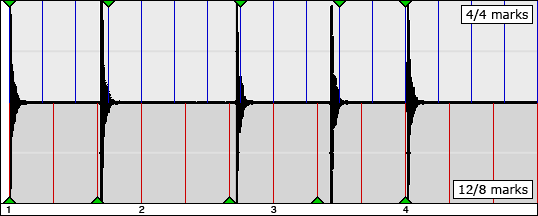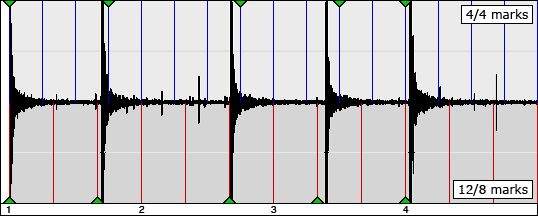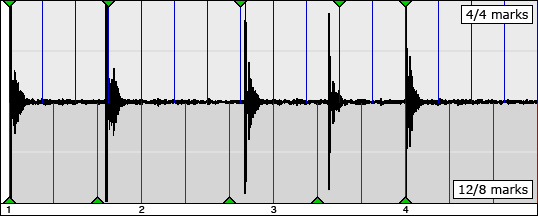What, exactly, is rumba clave?
I don't mean that in a Latin Music 101 kind of way, but in the real world, how do rumberos play clave? And is there a "correct" rumba clave? How much room is there for personal (or regional) style? How does tempo affect the placement of the five notes? Has it changed over time?
One thing is certain: What you see in standard western notation as written-clave is a long way from what's actually played.
But what is actually played? And can that somehow be illustrated? Well, I took a shot at it (with recordings containing rumba clave, a music editor, and Photoshop), and you'll find the results below.
To better illustrate the difference between what's written and what's actually played, the first two tracks are examples of straight clave (aka "written-clave"), both in 4/4 and 12/8. The 12/8 clave presented here is really just a stripped-down version of the standard 12/8 bell pattern, with the first note of each of the two double-hits removed.
Illustration notes:
For a given clave recording we want to be able to see where the notes fall in relation to both 4/4 and 12/8 written-clave. To that end, each illustration has the following components:
- 4/4 marks at the top in blue:
A given amount of time, in this case one measure of clave, can be broken into 16 graphical units of equal width/time, representing 16th notes. - 4/4 written-style rumba clave marks (green arrows at top)
- 12/8 marks at the bottom in red:
The same amount of time can also be broken into 12 graphical units of equal width/time. - 12/8 written-style rumba clave marks (green arrows at bottom)
- Basic 4-beat pulse per one measure of clave at bottom (same position in time for both 4/4 and 12/8 claves).
- Waveform of clave:
Viewed in a music editor. One measure, usually the first from a given track, as it's the cleanest.
The tracks chosen all have at least one complete measure of only rumba clave, without other instruments (especially palitos) unduly cluttering up the waveform and impacting the accuracy of the graphing. I tried to come up with a set that contains tracks of (1) various tempos, (2) the same tempo by different players/groups, and (3) different eras. Little consideration was given to whether I actually liked a track/song (though there are some good ones here); the fact is that there just aren't that many tracks out there suited to this purpose.
(Note: I did not research the individual actually playing claves on each track - the group/singer/leader listed next to "Artist" will have to suffice.)
30-second audio clips of each track are included as well, along with notations for beats per minute (bpm). Conclusions are at the bottom of page.
[Note on audio clips: Some people with IE are having issues - if they don't work, try Firefox or Safari.]
Written/Straight Clave in 4/4, 112 bpm

Written/Straight Clave in 12/8, 112 bpm

Speed: 98 bpm
Artist: Isaac Delgado | Album: Rumba Pa'l Pueblo | Track: Santa Cecelia

Speed: 100 bpm
Artist: Rumberos de Cuba | Album: ¿Dónde Andabas Tú, Acereko? | Track: El Trovador

Speed: 102 bpm
Artist: Rumboleros | Album: Protesta Carabali | Track: Linda Habana Yambu

Speed: 116 bpm
Artist: Carlos Embale | Album: Rumbero Mayor II | Track: Chambeleque

Speed: 122 bpm
Artist: Afrekete | Album: Iyabakua | Track: Timbata

Speed: 122 bpm
Artist: Los Parragueños | Album: Rumba Rarities | Track: Virgencita de Mi Camino

Speed: 138 bpm
Artist: Los Munequitos de Matanzas | Album: Rumba Caliente 88/77 | Track: Mi Arere

Speed: 144 bpm
Artist: Pancho Quinto | Album: En El Solar La Cueva Del Humo | Track: La Media

Speed: 156 bpm
Artist: Clave y Guaguanco | Album: Dejala en La Puntica | Track: Capricho de Abuela

Speed: 168 bpm
Artist: Ecue Tumba | Album: En Un Solar De Pogoloti | Track: Guaguanco Matancero

Conclusions:
The biggest thing that stands out, both graphically and in the audio, is just how different the written clave is to what's in the recordings. No surprise there, really, but it's amazingly clear when laid our like this.
Also, I came into this with the idea that at slower Yambu-like tempos, the feel would be closer to straight 4/4 time, and then as the tempo increased the clave would be played closer and closer to straight 12/8. I can no longer say that is strictly the case, as evidenced by the strong similarity between the clave in the Carlos Embale track at 116 bpm and that of the Clave y Guaguanco track at 156 bpm, both of which have a strong 12/8 feel.
Overall, though, what really strikes me is just how much variability there is, and that speaks to this conclusion:
That being said, however, the data illustrated does lead to certain observations and a recognition of standard/best practices. Let's take it note by note:
1st note:
A given; it's always on the ONE (at steady tempos).
2nd note:
In all cases but one (the Los Parragueños track at 122 bpm), it's either right on the 4/4 mark or pulled forward in time, in some cases all the way to the 12/8 mark. Although the tracks with the strongest 12/8 feel here are really fast, there are slower tracks here that also have the 2nd note placement closer to 12/8.
3rd note:
Almost the same scenario as for the 2nd note, with a lot of variability. For a given track, the placement of the 3rd note mirrors the 2nd in relation to the marks (i.e., if the 2nd note is pushed/delayed, the 3rd note will be pushed just about the same amount). The only real exception is the Ecue Tumba track at 168 bpm.
4th note:
OK, this one is key. Regardless of what happens with the 2nd, 3rd, and 5th notes, this one has amazingly highly consistent placement across all tracks and speeds. It's NEVER played on the 4/4 mark or after - ALWAYS before. Always pulled forward in time. Never quite as far as the 12/8 mark, but right in there between 4/4 and 12/8 (along the lines of Mike Spiro's idea of "FIX" - between Four and Six).
5th note:
Consistently right on the 4/4 mark or a bit after - never before.
Other observations:
Although the last 3 notes are never quite equidistant (as they would be played in straight 12/8), their relative spacing is far from straight 4/4 written-clave (with that big pause between the 3rd and 4th notes, and the last two notes clustered together at the end).
I think the nine tracks presented here reflect a fair sampling of how rumba clave is really played, though one must bear in mind that for each track only one measure of clave has been pulled out and illustrated. There is no doubt some variability throughout any given track. Also, I did sample from the beginnings of the songs, before the other instruments came in, and it's possible that in some cases the clave might shift in relation to whatever else is going on, and/or settle in as the groove gets established, but I would think this to be less of an issue with established groups playing together regularly.
Answering all the questions brought up in the intro is not yet possible; any input you might have would be greatly appreciated. Hopefully we'll fill in the blanks.
Back to the woodshed,
James
( jemuzu [at] gmail [dot] com )
(Special thanks to Mike Spiro and David Penalosa for their inspiration for this project.)
Note: For consistency and simplicity, I intentionally left Columbia and other rhythms containing rumba clave out of this for now.
16 comments:
this is great stuff - very interesting. Its difficult, though to get a good idea of how much difference is due to individual style and how much to random variation. If a few bars from the same song were there we could see whether the players are just randomly wavering away from exact time rather than playing with a particular feel.
Wow. This is just what I needed. Incredibly eye-opening. I've often been confused by my teacher's clave timing, since it doesn't fall precisely on the 4/4 meter. Now I have a better appreciation of the feel and style.
I wanted to add that I'd be really curious to see a similar breakdown for 6/8 bell.
Thanks for you efforts, hope to see more from you on this subject.
Thank you! Excellent info, something that can't be found in books. This shows how misleading are all efforts to note down Afro-Cuban music in western notation. Trust your ears! Play how you feel it, not how the metronome tells you. For me it's those small timing issues that give the music its soul.
Nice work James! It's nice to see it laid out that way. Now I just gotta learn how to play it...
Your images are inaccessible. Can you upload them to flickr or somewhere else so we can still see the analysis?
Images and clips restored.
~ James
These are great, very helpful, especially after reading Michael's great book.
Curious, what program are you using to generate these illustrations? Thx, Ray
>Curious, what program are you using to generate these illustrations?
I opened a track in Sound Studio (Mac) to see the waveform (of a little more than one-clave in length), took a screenshot, opened that up in Photoshop (where I'd already created a transparent template layer containing the grid and markings) and put the screenshot in as a layer underneath. There are some more details with getting the initial waveform screenshot done at a specific size, but that's basically what I did.
Your graphic work and analysis are much appreciated!
hello james,
a few years ago i read your analysis very interested, now i would like to read it again, but there are no images and music examples anymore- is ist possible to restore them again?
thanx for your great comments about the rumba -clave!
Images and clipped restored again, sorry.
Great analysis!
i would recommend to reconsider them using the hypothesis: cubans play polyrhythms so part of the clave would be in 4/4 and part in 6/8.
e.g. if you watch some Horacio el negro lessons he says this is what is actually happens, and your analysis seems to support that.
regards,
Erik
This is great stuff. I have been listening to rumba music for years and trying to figure out in my head exactly what you have so scientifically presented on this page. Great work, and thank you for sharing!
Thanks for sharing this intriguing analysis!
That fourth note really does stand out, doesn't it?
I was wondering whether we could understand its placement better by crossing the in-fours metre (4/4) with the in-threes (12/8). That would produce 48 sub-pulses (each a 1/48th note) to the clave (measure). Along those lines, visual inspection of your samples suggests that the fourth note most often falls about 2/3 of the way through the 10th 1/16th-note, that's at the 29th 1/48th note. And although it's sometimes earlier, it's never as early as the 28th, where the 7th strict written 1/12th note would fall. The closest approach to the strict 7/12 mark is in the track from Clave y Guaguanco, which is anyway remarkably close to the strict 12/8 marks, except for a slight delay in the middle three.
But I don't suppose that the musicians are counting 29 or higher! Instead, I think that Mike Spiro's idea of "FIX" - between Four and sIX - that you mentioned makes a lot of sense. [Or should that be "TWEE" - between TWo and thrEE? ;-)] Or perhaps, as Erik Vosmeijer commented, it's a polyrhythm, part of the measure being counted in twos and part in threes.
Could I point out that there's a big difference implied by the strict timings in the gap between the 3rd and 4th notes, t34, compared with that between the 4th and 5th, t45? According to strict 4/4, we count t34 = 3 and t45 = 2 (sixteenths), so their ratio is 3:2; but in strict 12/8, we count t34 = 2 and t45 = 2 (twelfths), so their ratio is 2:2 = 1:1. Again, visually, most of your samples - except again for the almost strict 12/8 feel of Clave y Guaguanco - it seems to me that the actual ratio of t34:t45 is closer to 4:3. These are small numbers that experienced musicians could probably feel quite easily. Here's a simple experiment: Taking some measurements of these intervals from your samples might establish that their ratio falls in a fairly small span about 4:3; certainly it'll almost always be greater than the 1:1 implied by strict 12/8. What do you think of this idea?
Post a Comment